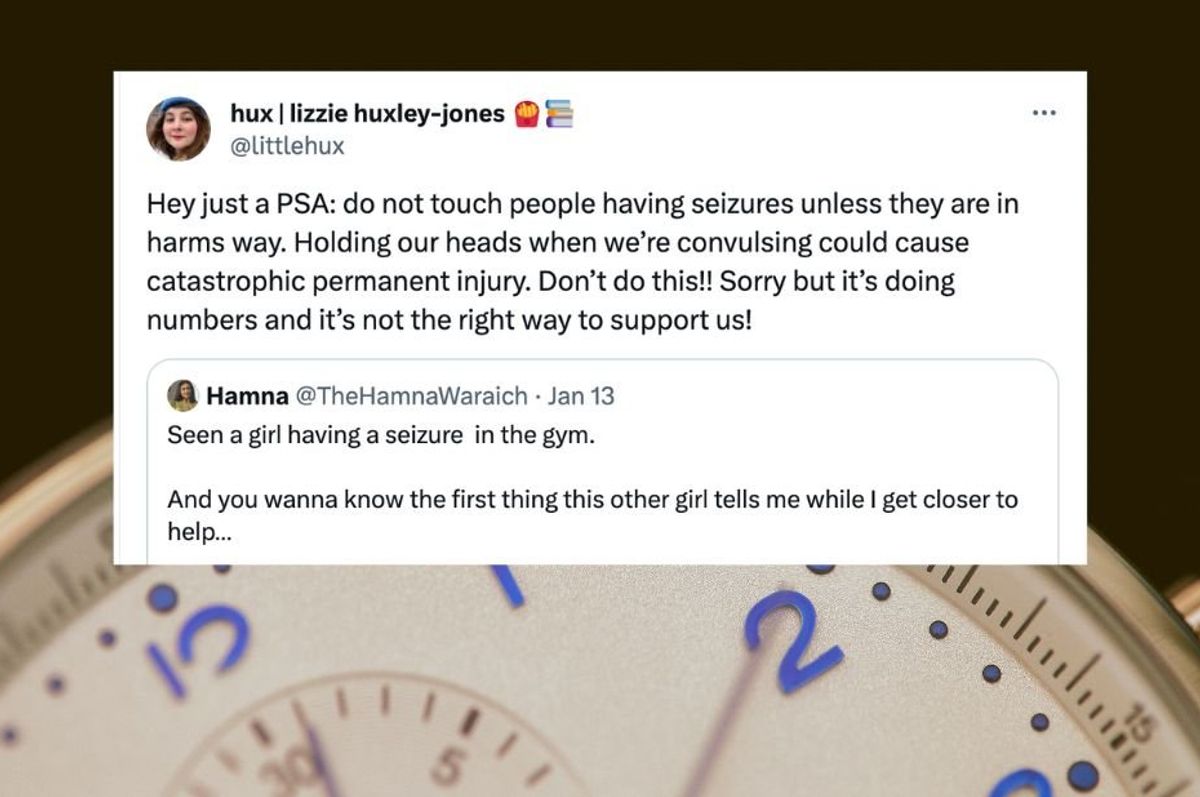An impassioned plea to help someone having a seizure leads to some much-needed education
Here's what to do and what not to do if you witness someone having a seizure.

There are some specific do's and don'ts in seizure first aid.
What should you do if you witness someone having a seizure?
Many of us have learned the basics of CPR or the Heimlich maneuver, even if we've never had to utilize those skills in real life. But seizures are a whole different ball game, and many people may not know what to do if they witness someone having one.
It’s important to learn what various medical events look like and what to and not do when they happen, because sometimes interventions that seems helpful can actually do harm, which is the case when someone is having a seizure.
A seizure is a sudden burst of uncontrolled electrical signals in the brain. There are many different kinds of seizures, but the most visibly recognizable kinds can cause a person’s body to become stiff, contort, convulse and/or twitch involuntarily. From the outside, a seizure can look painful, but most of the time the person seizing is not experiencing pain. Seizures can also appear to be frightening, as the person may lose control of their facial expressions, might gasp or gurgle or moan and may drool or foam at the mouth.
A thread on X showcases how someone with good intentions can react to witnessing a seizure in ways that can cause more harm than good, and the discussion led to some valuable education about what to do and not do if you see someone having a seizure.
The original tweet in the thread came from a person who was at the gym when they saw a girl experiencing a seizure. As they tried to get closer to help her, someone else said, “Give her space, don’t touch her.”
“She was lying in a pool of her own saliva with full body convulsions,” the person wrote, “And you’re telling me to leave her alone? This is why the west is a failed society. A person can be dying in front of them and they’d be too scared to ‘touch’ someone.”
The person said they “held her face up so she could breathe and not lay in spit” and rubbed her back until she stopped convulsing, wiped her face and the mat of her saliva after she came to and rubbed her hand while waiting for the paramedics to arrive “so she didn’t feel alone.”
The person went on to lament about how “dark” the world is. “The lack of socialization has made the youth weak in ways you can’t imagine. The cowardice stems from lack of intuition and actual empathy,” they wrote.
They then implored people to “take care of your neighbors” and “do the right thing even if you’re scared to offend,” which undoubtedly came from a kind-hearted place. But as many people with expertise and experience in managing seizures pointed out in response, what the person did was not entirely the "right thing" to do in this situation.
Many people who have seizure disorders chimed in to say it's actually best not to touch them when they are seizing as it can actually lead to injury. Holding a seizing person's head isn't the proper way to keep them from choking or to protect their head.
However, the advice to not touch the person at all is not a hard and fast rule, either. According to the CDC, here are the proper things to do if you are worried that the seizing person might injure themselves:
- If they are upright, help ease them gently to the floor.
- Turn the person gently onto one side. This will help the person breathe.
- Clear the area around the person of anything hard or sharp. This can prevent injury.
- Put something soft and flat, like a folded jacket, under his or her head.
- Remove eyeglasses.
- Loosen ties or anything around the neck that may make it hard to breathe.
- Time the seizure. Call 911 if the seizure lasts longer than 5 minutes.
As for what not to do, the CDC lists:
- Do not hold the person down or try to stop his or her movements.
- Do not put anything in the person’s mouth. This can injure teeth or the jaw. A person having a seizure cannot swallow his or her tongue.
- Do not try to give mouth-to-mouth breaths (like CPR). People usually start breathing again on their own after a seizure.
- Do not offer the person water or food until he or she is fully alert.
Seizures aren't fun but they're usually not life-threatening. The CDC says you only need to call 911 if:
- The person has never had a seizure before.
- The person has difficulty breathing or waking after the seizure.
- The seizure lasts longer than 5 minutes.
- The person has another seizure soon after the first one.
- The person is hurt during the seizure.
- The seizure happens in water.
- The person has a health condition like diabetes, heart disease, or is pregnant.
- Surgeons had violinist play during her own brain surgery so they didn't affect her talents ›
- A teenager having a seizure in the UK was saved by an online gamer 5,000 miles away in Texas ›
- Woman's viral thread about a stranger on the train asking her for help is a must-read. ›
- Husband's reactions to wife's seizures is gaining praise - Upworthy ›

